Much of the current drug news from around the country focuses on heroin and narcotic painkillers. Methamphetamine is sometimes thought of as yesterday’s news, but in many areas it is still a raging problem. In 2013, news outlets reported that Tennessee had become the leading state in the U.S. for meth use. Now a new law has gone into effect that legislators and law enforcement officials hope will crack down on the epidemic in Tennessee that is costing taxpayers $1 billion a year.
The Meth Problem
It was more than a decade ago that meth labs started springing up around the country, but particularly in rural areas. Methamphetamine is a controlled substance that can be prescribed by a doctor, but rarely is. The side effects and the potential for abuse are so great that it is a last-resort medication for some medical conditions, including ADHD and obesity.
Effects Of Meth
Meth is susceptible to abuse because it is a stimulant and gives the user energy as well as a euphoric feeling. On the downside, meth can cause:
 high blood pressure
high blood pressure- an elevated body temperature
- dry mouth
- jaw-clenching
- memory loss
- aggression
- paranoia
- anxiety
- insomnia
- brain damage
- organ damage
- severe dental problems
- violent behavior
It is also highly addictive and with prolonged and continued use, the negative side effects increase.
Meth has become such a huge problem because it is relatively easy to make. With just a few ingredients, including an over-the-counter cough medicine ingredient, anyone can make it in a home lab. These labs are abundant in Tennessee and the drug has been having disastrous effects on individuals and families in the state.
How Tennessee’s New Law Is Limiting The Purchase Of Pseudoephedrine
While other states have enacted and enforced strict laws regarding the purchase of cough medicine that have helped cut down on meth manufacturing and use, Tennessee has fallen behind. A bill passed in April can now change the course of Tennessee’s meth trajectory. The new law restricts the purchase of medicines containing pseudoephedrine, the cough medicine ingredient for making meth, to 48 tablets per month and 240 per year. The cap previously sat at 75 tablets per month. Some lawmakers wanted to slash that maximum even further, but a compromise was set at 48.
It may seem like a no-brainer to restrict pseudoephedrine, but there are plenty of law-abiding Tennesseans who depend on the medication for allergy relief. Some opponents of the bill argued that it was unfair to restrict access to the medication and stated that most of the meth used in Tennessee comes from other states. Still, the majority of lawmakers agreed that slashing the maximum allowance would curb meth use in the state.
As part of the restriction on buying pseudoephedrine, consumers’ purchases of the medication will be tracked. Those with a real medical need for more pseudoephedrine will be able to go over the limit with a doctor’s prescription. The need for more restrictions on meth-making ingredients is great and many feel that this new law meets that need. Others are skeptical, but only time will tell if Tennesseans are really ready to kick the meth habit.
Read Other News In Addiction And Addiction Rehab
A recent study from the University of California, San Diego (UCSD) found that men infected with HIV who use methamphetamine may experience faster T-cell activation and proliferation. In other words, the use of methamphetamine may cause HIV to progress more rapidly to AIDS.
Who Was Studied?
 The study looked at 50 men who have sex with men (MSM). The average age of the participants was 46, and each had been on retroviral medication for HIV for an average of four years. Forty-two percent of the participants were white, 20 percent were black and 4 percent were Hispanic.
The study looked at 50 men who have sex with men (MSM). The average age of the participants was 46, and each had been on retroviral medication for HIV for an average of four years. Forty-two percent of the participants were white, 20 percent were black and 4 percent were Hispanic.
Once a month for a year, the study participants completed a survey about their adherence to antiretroviral treatment and their use of various party drugs. Twenty of the men reported using marijuana during the study period, 16 used meth, 12 reported drinking alcohol, 11 used cocaine and 13 of the respondents used some other party drug.
The researchers also used frozen samples of a type of blood cell with a round nucleus known as peripheral blood mononuclear cells (PBMCs) to evaluate reservoirs of HIV DNA, cellular HIV RNA, and the activation and proliferation of immune cells named CD4 and CD8 (sometimes known as T-helper cells or T cells). HIV binds itself to CD4 cells, which multiply in order to help combat infection. In this way, the immune system actually makes more copies of the virus it is trying to destroy.
What The UCSD Study Found
The UCSD study found that the men who used meth had higher levels of activated and proliferating CD8 and CD8 cells, poorer CD4/CD8 ratios, and greater reservoirs of HIV DNA that had been incorporated into the genetic material of a host cell—proviral HIV DNA.
The study also found higher cytomegalovirus (CMV) load and shedding in the semen of meth users. While HIV is a sexually transmitted disease (STD), and sexual activity remains the leading cause of HIV transmission around the world, levels of HIV in the semen of an infected man are actually lower than the levels of HIV in the blood. However, HIV levels in semen are higher in a subgroup of men, and the UCSD study found that HIV levels in semen were more likely to be high in the men who used meth. A higher level of HIV in semen makes it more likely that an infected man could transmit the disease through unprotected intercourse. Previous studies have found that HIV transmission among meth users occurs at a higher rate than among other HIV-positive individuals.
Although the participants in this study reported a variety of recreational drug use, meth was the only drug that appeared to have any significant influence on T-cell activation and proliferation, and on levels of proviral HIV DNA.
In order to eliminate variables that could also explain the difference in the progression of HIV, the researchers selected MSM of a similar age, with similar baseline CD4 and CD8 counts, who had spent a similar amount of time on antiretroviral medications, and who were not infected with any other STDs that could contribute to the worsening of their HIV.
Researchers do not yet understand why the use of methamphetamine could speed the progression from HIV to AIDS or increase cognitive impairment among men with HIV. One possibility is that meth use corresponds with difficulty sticking to a regimen of anti-viral medication (although the men in this study who used meth reported similar rates of adherence as non-meth users). Risky behaviors common to meth users may also have something to do with speeding health deterioration among men with HIV.
However, the fact that the other recreational substances used by men in the study did not affect their HIV makes it somewhat less likely that risky behaviors associated with drug use will successfully explain the way meth affects HIV. It may be that there is some physiological cause and effect through which meth use directly promotes AIDS progression and increased cognitive deterioration.
If you or someone you love is struggling with a drug or alcohol addiction – Call us now – Help is available 24/7…It’s worth it!
The similarity in names suggests that there is a fundamental similarity between amphetamine and methamphetamine. How are they different? How are they the same? While the drugs have the same chemical base, the process they undergo drastically alters the effect they have on the body. The methamphetamine vs. amphetamine question may be used to try to determine which is more harmful or which is more addictive. While the drugs bear similarities, their differences are significant. Read on to understand more about each.
Amphetamines
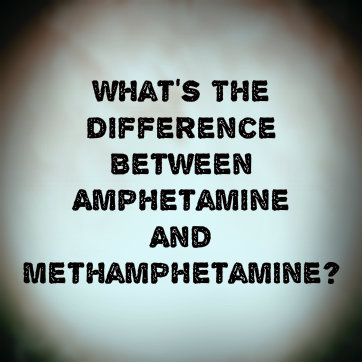 Amphetamine has a variety of medical uses and drugs containing amphetamines have been prescribed by physicians for a variety of conditions. For example, because amphetamines are powerful psychostimulants and increase metabolism, they have often been incorporated into prescription weight loss aids. Amphetamines also have the ability to increase focus and heighten mental clarity and thus have been prescribed to treat those struggling with attention-deficit hyperactivity disorder (ADHD) or to help soldiers stay awake during long stints in the field.
Amphetamine has a variety of medical uses and drugs containing amphetamines have been prescribed by physicians for a variety of conditions. For example, because amphetamines are powerful psychostimulants and increase metabolism, they have often been incorporated into prescription weight loss aids. Amphetamines also have the ability to increase focus and heighten mental clarity and thus have been prescribed to treat those struggling with attention-deficit hyperactivity disorder (ADHD) or to help soldiers stay awake during long stints in the field.
Methamphetamines
Methamphetamine is more commonly associated with illegal, recreational use and is never prescribed medically. Methamphetamine is amphetamine double methylated (amphetamine is methylated once). The science behind this may be complicated for the layperson, but the important thing to understand is that methamphetamine, because it has been methylated twice, is significantly faster acting, more potent, and more addictive, and thus quite a bit more dangerous.
The result of both is euphoria because of increased release of norepinephrine and dopamine in the brain. This release of pleasure chemicals stimulates the brain’s reward center, enticing the user to not only continue use, but, as tolerance develops, to crave ever increasing levels of the drug.
The effects of use are similar in both amphetamines and methamphetamines including increased pulse, hyperactivity, dizziness, and insomnia, but the effects are more potent with methamphetamines. When taken exactly as prescribed and under the careful monitoring of a physician, amphetamine usage can be safe. The same cannot be said of methamphetamines, for which experimentation can carry grave results.
Abuse Of Amphetamine And Methamphetamine
Though amphetamines may boast a variety of medical uses, the prescription drugs containing amphetamines still carry risk as well as unfavorable side effects. These drugs are highly addictive and carry significant potential for abuse.
While they have unique and distinct effects on the body, in both cases the body develops tolerance rapidly and more and more of the drug is required to achieve the desired results. Even if an individual does desire to stop taking the amphetamine-based prescription or to stop using meth, the physical dependence can throw the individual into severe withdrawal.
It is recommended that those intending to cease use of amphetamines or methamphetamines do so under the care and supervision of a doctor or with the assistance of a drug rehab program and related therapy.
So amphetamine vs. methamphetamine isn’t really the issue. Both drugs are potent and dangerous with the potential for abuse and addiction. While amphetamine may be used safely under the supervision of a physician, it still carries risk and should be taken with caution and care.
If You Or Someone You Know Is Struggling With An Addiction
Call Us Now – We Are Available 24/7
Methamphetamine is a highly addictive stimulant drug of abuse that produces substantially more profound effects on normal brain chemistry than cocaine. Repeated, long-term (i.e., chronic) users of this drug have very strong chances of developing diagnosable issues with drug abuse and drug addiction. In March 2014, researchers from the RAND Corporation presented the White House Office of National Drug Control Policy with a detailed report that, among other things, estimates the number of Americans affected by chronic methamphetamine use from 2000 to 2010. This report also breaks down chronic users of the drug into three levels of habitual intake.
What Constitutes A Meth User?
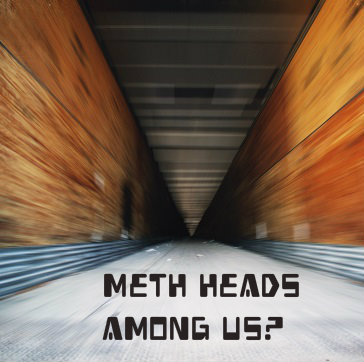 Each year, federal researchers from the Substance Abuse and Mental Health Services Administration use a project called the National Survey on Drug Use and Health to estimate the overall prevalence of methamphetamine use among American teenagers and adults. Figures released in late 2013 for the 2012 version of this survey indicate that 0.2 percent of the total population age 12 or older used the drug in an average or representative month. In raw numbers, this equates to about 440,000 people. In addition, approximately 0.4 percent of the teen and adult population used methamphetamine at some point during the entire survey year. This percentage equates to roughly 1.2 million people. Another project funded by the National Institute on Drug Abuse, called Monitoring the Future, tracks methamphetamine use among all 8th, 10th and 12th graders. All told, about 1 percent of students enrolled in these three grades used the drug at least one time in 2012.
Each year, federal researchers from the Substance Abuse and Mental Health Services Administration use a project called the National Survey on Drug Use and Health to estimate the overall prevalence of methamphetamine use among American teenagers and adults. Figures released in late 2013 for the 2012 version of this survey indicate that 0.2 percent of the total population age 12 or older used the drug in an average or representative month. In raw numbers, this equates to about 440,000 people. In addition, approximately 0.4 percent of the teen and adult population used methamphetamine at some point during the entire survey year. This percentage equates to roughly 1.2 million people. Another project funded by the National Institute on Drug Abuse, called Monitoring the Future, tracks methamphetamine use among all 8th, 10th and 12th graders. All told, about 1 percent of students enrolled in these three grades used the drug at least one time in 2012.
The Levels Of Chronic Meth Use
All chronic drug users repeatedly take a given substance over time. However, the actual frequency of intake between different chronic users can vary quite substantially. For instance, “low level” chronic users may regularly take a drug about four to 10 days a month. “Moderate- to high-level” chronic users may regularly take a drug about 11 to 20 days a month. The most extreme level of chronic use involves drug intake on a minimum of 21 days a month. Chronic drug use and the onset of diagnosable abuse and addiction typically go hand in hand. Compared to other habitual users, heavy chronic users commonly experience particularly intense forms of these problems. In the U.S., diagnosable cases of methamphetamine abuse and addiction fall under the heading of a larger condition called stimulant use disorder, which also encompasses abuse and addiction associated with the use of cocaine, amphetamine and other stimulant substances.
How Many Chronic Methamphetamine Users Are There?
In the report presented to the White House Office of National Drug Control Policy, the research team from the RAND Corporation used data gathered from several well-regarded sources to calculate how many people in the U.S. qualified as chronic methamphetamine users for each year between 2000 and 2010. Among others, these sources included that National Survey on Drug Use and Health and a periodically conducted project called the Arrestee Drug Abuse Monitoring Program, which tracked drug use rates in people who get arrested or otherwise come under the jurisdiction of the criminal justice system. In 2010, the most likely total number of chronic methamphetamine was about 1.6 million. The actual number of affected individuals may have been as low as 700,000 or as high as 2.7 million. For a number of reasons (including the relatively high rate of drug use among incarcerated individuals), the figures from the RAND report are substantially higher than the estimates produced by the National Survey on Drug Use and Health.
Roughly 600,000 of the people classified as chronic methamphetamine users in 2010 took the drug on four to 10 separate days per month. A slightly smaller number of chronic users (500,000) took the drug on 11 to 20 separate days per month. In addition, about 500,000 chronic methamphetamine users took the drug on 21 or more separate days per month.
The authors of the RAND Corporation report note that it’s quite difficult to accurately determine how many people in the U.S. have been involved in chronic methamphetamine use since the beginning of the 2000s. These difficulties stem largely from changes in the programs used to gather information on methamphetamine use. For example, methods employed by the National Survey on Drug Use and Health to calculate this use were changed significantly in 2007. In addition, there is only incomplete information available from the Arrestee Drug Abuse Monitoring Program (which also completely lost its federal funding in 2012).
Read About How Bath Salts Are 10 Times More Addictive Than Meth
Crystal methamphetamine (crystal meth) is an illegal, illicitly produced form of methamphetamine, a tightly controlled stimulant drug with limited but real usefulness as a legitimate medication. People who use/abuse this illegal product run significant risks for developing a range of serious or potentially deadly health complications. According to the results of a study published in October 2013 in the Canadian Medical Association Journal, teenagers and young adults who use crystal meth substantially increase their chances of getting involved in IV (intravenous) drug use, a form of drug use strongly associated with severe substance-related health problems.
How Methamphetamine And Crystal Meth Effects The Body
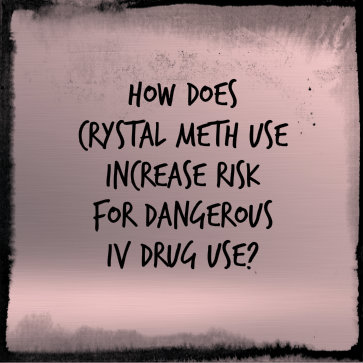 Methamphetamine is a close chemical relative of amphetamine; like that well-known stimulant medication, it produces euphoric sensations and sharply boosts the baseline activity rate inside the brain. Over time, the brain can get accustomed to methamphetamine’s effects and develop a dependence on the drug’s presence. In turn, dependence on methamphetamine is often a precursor for methamphetamine addiction, a highly disruptive and destructive combination of dependence, drug cravings and drug-oriented lifestyle patterns. Doctors occasionally prescribe legal, pharmaceutically manufactured methamphetamine to treat cases of narcolepsy, severe obesity or attention-deficit/hyperactivity disorder (ADHD).
Methamphetamine is a close chemical relative of amphetamine; like that well-known stimulant medication, it produces euphoric sensations and sharply boosts the baseline activity rate inside the brain. Over time, the brain can get accustomed to methamphetamine’s effects and develop a dependence on the drug’s presence. In turn, dependence on methamphetamine is often a precursor for methamphetamine addiction, a highly disruptive and destructive combination of dependence, drug cravings and drug-oriented lifestyle patterns. Doctors occasionally prescribe legal, pharmaceutically manufactured methamphetamine to treat cases of narcolepsy, severe obesity or attention-deficit/hyperactivity disorder (ADHD).
Crystal meth gets its name from its characteristic crystalline appearance. In America, most of the available supply of this drug comes from illegal, large-scale manufacturing facilities located on U.S. territory or in other countries. Some crystal meth also comes from small-scale operations that only service local areas. Depending on the process used during its creation, illegally made methamphetamine can contain a number of highly dangerous compounds, including sulfuric acid, acetone, hydrochloric acid or red phosphorus. Since use of crystal meth inevitably takes place outside of a legitimate medical context, it inherently constitutes a form of drug abuse. People who habitually use the drug have exceedingly high risks for developing an addiction or other major health problems such as drug overdoses, disturbed or violent mood shifts, extreme tooth and gum damage (meth mouth) and psychosis (hallucinations and/or delusional thought processes).
IV Drug Use
IV drug use is the common term for the purposeful injection of drugs directly into the bloodstream. As a rule, doctors and other medical professionals use this term in reference to the injection of recreational substances rather than medications. IV drug abusers commonly rely on direct bloodstream access to rapidly deliver substances to their brains, and thereby rapidly trigger the effects associated with those substances. IV drug injection carries risks above and beyond the risks classically associated with recreational drug use in general.
IV Drug Use Risks
- Increased chances of drug overdose
- Dangerous or lethal infections such as hiv/aids or hepatitis b or c
- Lethal infection-related complications such as bacteremia or sepsis
- Increased chances of developing pneumonia
- And increased chances of dangerous contaminants or additives
How Crystal Meth Use Increases Chance Of Falling Into IV Drug Use
In the study published in the Canadian Medical Association Journal, researchers from several Canadian institutions used information gathered from a project called the At-Risk Youth Study to examine the potential connection between crystal meth use and the initiation of IV drug use among teenagers and young adults between the ages of 14 and 26. All told, 991 individuals submitted answers to questionnaires regarding their baseline drug-using behaviors. At the beginning of the study, 395 of these individuals were crystal methamphetamine users, while another 390 were IV drug users. The researchers tracked the drug use patterns of all 991 participants over five years in order to uncover any developing trends.
Altogether, 16 percent of the participants not initially involved in IV drug use began taking drugs intravenously over the course of the study. After analyzing their data, the researchers found that the recent use of a non-injectable form of crystal methamphetamine is clearly linked to increased chances of beginning IV drug use. In most cases, prior users of non-injectable crystal meth choose this drug for their first forays into intravenous use. The researchers also found that the average young user of crystal meth who initiates IV drug intake makes the transition to intravenous use at the exceptionally early age of 14.
Meth Treatment Significantly Needed In City, Street Culture
The authors of the study published in the Canadian Medical Association Journal gathered their data from young people either living on the street or heavily involved in local street culture. They believe that their findings indicate an urgent need to address crystal methamphetamine use in this population and curb the transition to IV drug use.
Read More About The Connection Between Hepatitis C And IV Drug Users And Get Help Today!
11 Nov 2013
Meth Addiction And The Effects In Teens
Fans of the hit crime drama Breaking Bad may have become familiar with the dangers of methamphetamine use. However, as a parent, you may have questions about methamphetamine abuse in teenagers and whether it requires drug rehab treatment. Surveys suggest that 2 to 3.5% of adolescents have used methamphetamines [1]. Also called “speed” or “glass”, it’s a highly addictive stimulant.
How Meth Works
Methamphetamine – or “meth” for short – is a type of amphetamine, a drug that acts on the body’s central nervous system. The drug works by increasing dopamine levels within the brain to very high levels. Dopamine is the brain chemical that’s linked to pleasure, reward, motivation, and also motor function. When dopamine levels skyrocket, as they do during meth use, the user experiences a pleasurable rush that is often compared to euphoria.
While there are several types of amphetamines, meth is generally considered the most potent. The drug can be snorted, injected, or taken orally. Some abusers use a method called parachuting, which involves crushing a pill and then rolling the powder into a piece of tissue or toilet paper. The entire package – tissue and all – is then swallowed, delivering what’s believed to be a stronger, faster high because the pill’s outer protective layer has been destroyed.
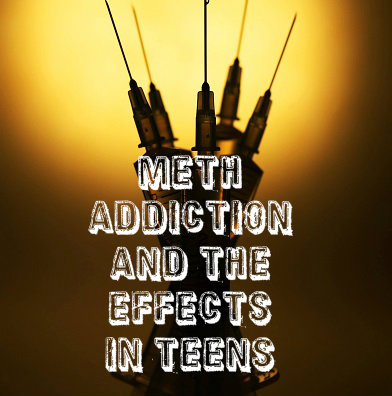 Teen meth addicts will typically use daily or nearly daily. Addiction requiring drug rehab treatment can develop quickly, sometimes within just a few uses. Chronic abuse of the drug leads to tolerance. As one’s tolerance level increases so does the amount of the drug that’s needed in order to achieve the euphoric high.
Teen meth addicts will typically use daily or nearly daily. Addiction requiring drug rehab treatment can develop quickly, sometimes within just a few uses. Chronic abuse of the drug leads to tolerance. As one’s tolerance level increases so does the amount of the drug that’s needed in order to achieve the euphoric high.
Effects Of Meth
Since meth is a stimulant, like cocaine, a teen will experience immediate physical effects, even when the drug is taken in small amounts. Meth users experience increased heart rate and respiration, irregular heartbeat, high body temperature, decreased appetite, inability to sleep, and increased physical activity.
An adolescent with a long-term meth addiction can experience more serious effects. Anxiety, confusion, and extreme weight loss are common. Many develop severe dental problems, such as tooth decay and loss, because the drug reduces output of saliva, which normally protects the mouth, and drug users often have poor dental hygiene.
Teen meth addicts are also at risk because the drug enhances the sex drive. Several studies have found that youth, especially females, who use meth are more likely to engage in risky sexual behaviors [2]. This potentially leads to unsafe sexual practices, including having sex without protection. Research has found a strong association between meth users and sexual risk-taking. A study of adults using meth found they were 1.7 times more likely to have gonorrhea and twice as likely to have chlamydia [3].
Chronic methamphetamine abusers might experience serious psychotic symptoms, including hallucinations, delusions, or paranoia. This can lead to physical problems as well. For instance, a meth user might scratch and gouge at their skin to remove “bugs.” Auditory hallucinations can be particularly dangerous if the addict believes “voices” are commanding him or her to harm others, a symptom that makes drug rehab treatment that much more important.
Meth use in teens can also cause permanent brain damage. Research shows that chronic use causes structural and functional changes to brain areas linked to memory and mood [4, 5]. In addition, brain imaging has shown that meth use changes the dopamine system in a way that reduces verbal learning and motor skills [6]. Using the drug over time also disrupts the body’s normal production of dopamine; as a result, chronic users show severe mood swings.
Signs Of Meth Abuse In Teens
- Euphoric moods (may appear unusually happy)
- Paranoia
- Reduced appetite
- Incessant talking
- Rapid weight loss
- Dilated pupils
- Dry, itchy skin
- Skin sores
- Intense mood swings
- Anxiety, nervousness
- Shaky hands
- Violent or aggressive behavior
- Excessive sweating
Symptoms can become worse as a teen’s meth addiction deepens. For instance, a meth addict often appears undernourished or even sick. He or she may have frequent mood swings, abruptly switching from chatty and friendly one moment to aggressive and hostile the next.
Treatment For Meth Addiction
Due to the serious short-term and long-term health risks, including brain damage and even death, meth addiction in adolescents requires immediate drug rehab treatment. Meth abusers can experience intense withdrawal symptoms, including severe agitation, anxiety, sleeplessness, and strong urges to use. Since withdrawal symptoms can be so powerful, teens should detox in a treatment center where they can be medically monitored.
After the drug is out of the body, your teen will start a treatment plan that will likely have several components based on his or her needs. Currently, there are no approved medications to treat methamphetamine addiction. However, rehab centers have a number of therapies for helping adolescents recover. For example, an addictions specialist may recommend cognitive behavioral therapy. This particular type of therapy helps teens learn more about the factors, such as negative emotions, irrational thoughts, or unhealthy behaviors, that contribute to their drug use. This therapy also teaches them how to deal with those factors in a drug-free way. Contingency management may also be beneficial in a drug treatment program. It provides tangible incentives, such as movie tickets or cash, for drug-free urine samples.
Alternate Therapies For Addiction
Other therapies may help your teen as well. For example, animal-assisted therapy, which involves the use of animals like dogs or horses, can be especially powerful. This treatment approach can help addicted teens reduce anxiety, build self-confidence, and develop trust. Talk with an addiction specialist to learn more about the benefits of animal-assisted therapy.
Family education and counseling will also be essential for guiding your teen through recovery. Educational sessions help parents and family members better understand the nature of addiction. They also show ways to help an addicted teen stay free of drugs. In family counseling, a therapist works with family members to pinpoint and resolve conflicts and communication issues, including those that have played a role in your teen’s decision to use drugs. Family therapy can play an important role in helping your teen avoid a relapse down the road.
Meth Affects The Brain’s Pleasure Center Long After Use
Treating an addiction to meth is challenging, in part, because the brain’s ability to produce dopamine is hampered for up to 6 months or more after drug use stops. As a result, addicts may be unable to experience pleasure. This can make it difficult for them to find enjoyment in even simple activities like spending time with friends, seeing a movie, or relaxing on the beach. This lack of positive emotion can compel many teens to start using again, just so they can feel some form of pleasure.
Yet, despite the challenges, adolescents can fully recover from a methamphetamine addiction. If you suspect or know that your teen is abusing meth, consult a drug rehab treatment as soon as possible – preferably one that is skilled in handling meth abuse and addiction in teens. The staff will work with you to lay out a plan for recovery that gives your teen the best chance for success.
Read More About What Meth Use Can Do To You
References:
[1] http://www.drugabuse.gov/drugs-abuse/methamphetamine
[2] http://www.biomedcentral.com/1471-2431/8/48/abstract
[3] http://www.healio.com/infectious-disease/hiv-aids/news/print/infectious-disease-news/%7B458a3b28-01a8-45ca-af13-dead2d781f8b%7D/methamphetamine-use-increases-risk-of-acquiring-hiv-stds-and-mrsa
[4] http://www.jneurosci.org/content/24/26/6028.long
[5] http://www.ncbi.nlm.nih.gov/pubmed/14706946
[6] http://www.ncbi.nlm.nih.gov/pubmed/11229977
Reporting the news in Mexico can be a deadly occupation, especially for those covering the drug war. But where militant thugs have been successful in stifling the media, they are virtually powerless against those who have taken to social media to “report” the war.
It’s not only Mexican residents caught in the crossfire taking to Twitter, YouTube and Facebook, those across the border in the U.S. are also using social media as a tool. Residents are using social media to protect themselves from the drug cartels that stop at nothing to push their product and protect their turf.
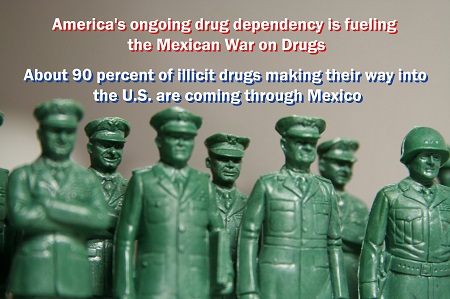 The violence began in earnest when the Mexican president declared war on drugs, but crept up another few notches when two major partnering cartels split and declared war on each other. Since the declarations of war, it is estimated that as many as 100,000 people have been killed and another 30,000 have seemingly vanished into thin air. Many residents try to escape the most violent areas, which has put more than 200,000 in a displaced status.
The violence began in earnest when the Mexican president declared war on drugs, but crept up another few notches when two major partnering cartels split and declared war on each other. Since the declarations of war, it is estimated that as many as 100,000 people have been killed and another 30,000 have seemingly vanished into thin air. Many residents try to escape the most violent areas, which has put more than 200,000 in a displaced status.
Some of the only news sources available now are through Twitter and Facebook. While news footage once came from the major broadcast companies in Mexico, camera phones with crudely edited footage of the war between the government and the cartels is being placed on YouTube instead. Media outlets in the U.S. are also depending on these amateur videos as their go-to source for footage.
America’s ongoing drug dependency is fueling this war. About 90 percent of illicit drugs making their way into the U.S. are coming through Mexico. The biggest cash crop, so to speak, continues to be cocaine.
According to the National Institute on Drug Abuse, nearly 5 million Americans said they had at one point or other abused cocaine. While those numbers pale in comparison to the drug’s peak in 1982 (10.5 million were believed to be using the drug in that year), it’s still enough to fuel a drug war that is taking lives.
Read more: United Nations Leading International War on Drugs
Methamphetamine is known for its ability to damage normal brain function in its users. Unfortunately, some of the damage done by the drug increases the likelihood that recovering addicts will experience a relapse and return to active methamphetamine abuse. At one time, doctors and researchers believed that meth addicts were incapable of regaining the mental function required to significantly decrease any relapse risks. However, current evidence indicates that many of the brain deficits that can lead to relapse will gradually fade away if people addicted to the drug can remain in recovery for an initial, crucial period of time.


